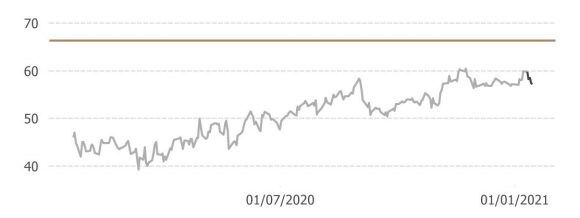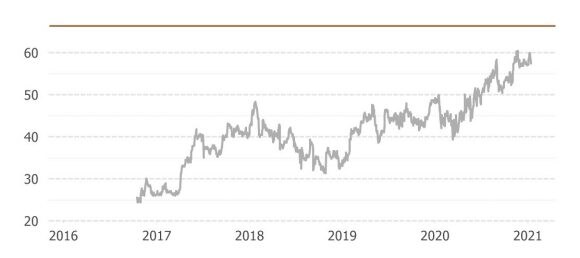Yum China Hld Rg (YUMC US)
Global Markets Comment
Global Markets Comment
Following strong Q320 results, we are confident in YUMC’s organic growth potential driven by store expansion through various brands and formats, remodelling and membership rollouts. YUMC has a first-mover advantage in lower tier cities through its expansion strategy and have continued to develop its digital business. YUMC’s app usage share gain have accelerated since July 2020 and has surpassed 2019's level as of October 2020. We believe re-rating is likely underway for YUMC as it expands its restaurant business while maintaining a leading digital position amongst quick service restaurants (QSRs) in China.
Performance since inception*

Company Profile
Company Profile
Yum China (YUMC) was spun off from Yum! Brands, one of the world's largest quick-service restaurant (QSR) and full-service restaurant groups and became its independent licensee in mainland China in November 2016. YUMC operates over 10,000 restaurants in more than 1,400 cities, mainly under the brands of KFC, the No.1 western QSR brand in China, and Pizza Hut, the No.1 pizza food-service group, according to Euromonitor. YUMC also owns the concepts of Taco Bell
Price History 1 year

Investment Case
Investment Case
Based on our expectation of a broad restaurant sector recovery, we believe YUMC's risk-reward profile is increasingly attractive, with its valuation (13x/11x 2021E/22E EV/EBITDA) at 20%/30% discounts to the global peer averages. We forecast an EBITDA CAGR of 14% in 2021-23E, driven by: 1) store unit expansion in lower-tier cities and satellite stores of Pizza Hut; 2) retailing potentially entering into a fast track supported by the recent launch of KaifengCai-branded packaged food products; and 3) increasing monetisation of memberships by selling privileges cards (about 45m YTD, or 16% of total memberships).
Price History 5 years

Risk in Investment Case
Risk in Investment Case
Key risk factors include 1) deteriorating macroeconomic factors that could negatively impact consumer spending; 2) food safety incidents at YUMC or other food companies; 3) increased competition and oversupply; 4) significant commodity, rental or labour cost inflation; 5) changing consumer eating habits; 6) inability to identify and secure appropriate sites for new restaurants and 7) fiercer competition introduced by the rise of online food delivery


